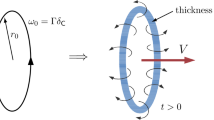Abstract
The growth of a two-dimensional liquid jet is modelled, in which an inviscid incompressible fluid is in irrotational flow. On the moving free surface, the pressure is constant. The flow is symmetric with respect to the y-axis. The free-surface fluid particle that lies on the y-axis is Q and it has position y = Y(t). A velocity potential is presented that describes the local features of the flow near the centreline, and which contains essentially two unknowns: the velocity V(t) = d Y/d t of Q, and a length L(t). Near Q the free surface is a time-dependent parabola, whose curvature is directly proportional to a third unknown, F(t). The kinematic and dynamic free-surface boundary conditions constrain V, L and F to satisfy three ordinary differential equations. The solutions are a one-parameter family that separate into five types. For one type the free-surface curvature changes sign during the motion, so that the free surface changes from concave to convex—it executes flip-through. Soon after flip-through, there is a local maximum in the pressure, with respect to time and space. A short time later there is a maximum in the acceleration of Q. As t tends to infinity, V tends to a constant, V ∞. An estimate is made of the time scale for flip-through, based on pressure changes, and it is found to decrease as V ∞ increases. When V ∞ is chosen very large, the values of the large maxima in pressure and acceleration become sensitive to small changes in the initial conditions. The results focus on the highly transient pressure field. The findings may help to describe the flip-through of a steep fronted water wave meeting a plane impermeable wall.
Similar content being viewed by others
References
Cooker MJ, Peregrine DH (1993) Impact pressures due to near breaking waves. In: Banner ML, Grimshaw RHJ (eds) IUTAM Symp. Breaking Waves. Springer, pp 291–297
Tuck EO (2000) Numerical solution for unsteady two-dimensional free surface flows. In: Miloh T, Zilman G (eds) 15th International Workshop on Water Waves and Floating Bodies. Caesarea, Israel, pp 174–177
Longuet-Higgins MS (2001) Vertical jets from standing waves: the bazooka effect. Proc R Soc Lond A457: 495–510
Longuet-Higgins MS, Dommermuth DG (2001) Vertical jets from standing waves. II. Proc R Soc Lond A457: 2137–2149
Shaw LL, Muelder SA, Baum DW, Winer KA (1994) Hypervelocity explosive-driven metal jet in air. Phys Fluids 6(9): 510
Taylor GI (1943) A formulation of Mr. Tuck’s conception of Munroe jets. In: Batchelor GK (ed) The scientific papers of Sir Geoffrey Ingram Taylor, vol 3. 358–362
Birkhoff G, MacDougall DP, Pugh EM, Taylor GI (1948) Explosives with lined cavities. J Appl Phys 19: 563–582
Birkhoff G, Zarantonello EH (1957) Jets wakes and cavities. Academic, New York
Gurevich MI (1965) Theory of jets in ideal fluids. Academic, New York
Cooker MJ (2002) Unsteady pressure fields which precede the launch of free surface liquid jets. Proc R Soc Lond A458: 473–488
Duchemin L, Josserand C, Clavin P (2005) Asymptotic behavior of the Rayleigh-Taylor instability. Phys Rev Lett 94: 224–501
Duchemin L (2008) Self-focusing of thin liquid jets. Proc R Soc Lond A464: 197–206
Howison SD, Ockendon JR, Wilson SH (1991) Incompressible water-entry at small dead-rise angles. J Fluid Mech 222: 215–230
Fraenkel LE, McLeod JB (1997) Some results for the entry of a blunt wedge into water. Phil Trans R Soc Lond A355: 523–535
Semenov YA, Iafrati A (2006) On the nonlinear water entry problem of asymmetric wedges. J Fluid Mech 547: 231–256
Korobkin AA (1995) Impact of two bodies one of which is covered by a thin layer of liquid. J Fluid Mech 300: 43–58
Howison SD, Ockendon J, Oliver JM, Purvis R, Smith FT (2005) Droplet impact on a thin fluid layer. J Fluid Mech 542: 1–23
Borisova EP, Koriavov PP, Moiseev NN (1959) Plane and axially symmetric similarity problems of penetration and of stream impact. J Appl Math Mech 23: 490–507
Zeff BW, Kleber B, Fineberg J, Lathrop DP (2000) Singularity dynamics in curvature collapse and jet eruption on a fluid surface. Nature 403: 401–404
Roisman IV, Tropea C (2002) Impact of a drop onto a wetted wall: description of crown formation and propagation. J Fluid Mech 472: 373–397
Korobkin AA, Scolan Y-M (2006) Three-dimensional theory of water impact. Part 2. Linearized Wagner problem. J Fluid Mech 549: 373–434
Longuet-Higgins MS, Oguz H (1995) Critical microjets in collapsing cavities. J Fluid Mech 290: 183–201
Korobkin AA, Yilmaz O (2009) The initial stage of dam-break flow. J Eng Math 63: 293–308
King AC, Needham DJ (1994) The initial development of a jet caused by fluid, body and free-surface interaction. I. A uniformly accelerating plate. J Fluid Mech 268: 89–101
Shu J-J (2004) Impact of an oblique breaking wave on a wall. Phys Fluids 16(3): 1–42
Needham DJ, Chamberlain PG, Billingham J (2008) The initial development of a jet caused by fluid, body and free-surface interaction. Part 3. An inclined accelerating plate. Q J Mech Appl Math 61: 581–614
Bagnold RA (1939) Interim report on wave pressure research. Proc Inst Civ Eng 12: 201–226
Bullock GN, Obhrai C, Peregrine DH, Bredmose H (2007) Violent breaking wave impacts. Part 1: results from large-scale regular wave tests on vertical and sloping walls. Coast Eng 54: 602–617
Author information
Authors and Affiliations
Corresponding author
Rights and permissions
About this article
Cite this article
Cooker, M.J. The flip-through of a plane inviscid jet with a free surface. J Eng Math 67, 137–152 (2010). https://doi.org/10.1007/s10665-009-9302-2
Received:
Accepted:
Published:
Issue Date:
DOI: https://doi.org/10.1007/s10665-009-9302-2




